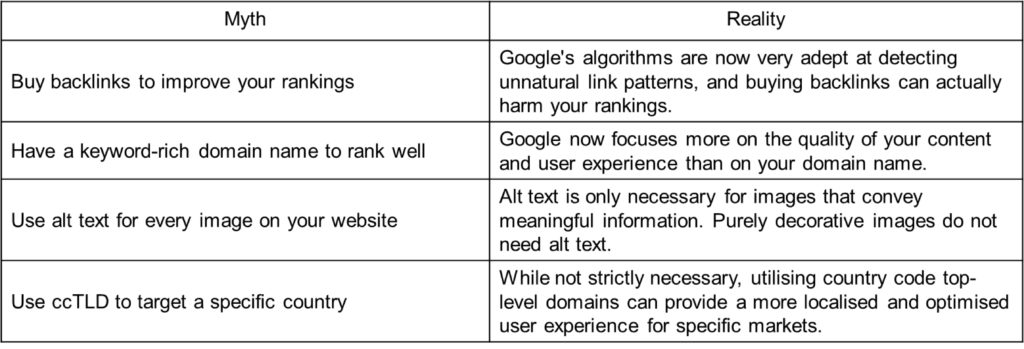Our previous article highlighted insights from the Search Central Live event in Jakarta – a flagship event by the Google Search Central team.
In this article, we will focus on debunking common SEO myths. By understanding these myths, you can avoid common mistakes and improve your website’s SEO.
During an insightful presentation at the recent Google Search Central Live Jakarta 2023 event, Garry Illyes, a Search advocate at Google, dispelled common SEO misconceptions, providing invaluable insights and clarifying best practices. Here are the common myths and facts discussed during the event.
Crawling and indexing
Contrary to a popular misconception, it is important to note that Google does not crawl and index every URL on the web. Instead, Google crawls a substantial but limited portion of the available web pages.
To determine which pages to crawl, Google employs sophisticated algorithms that consider various factors, such as the presence of incoming links, site authority, user location and preferences, and page content. Additionally, the extent of crawling for a particular site depends on its structure and adherence to the guidelines outlined in the site’s robots.txt file. Ultimately, Google prioritises crawling the pages deemed the highest quality and relevance for its users.
Buying backlinks – don’t
There is a prevailing misconception that purchasing backlinks can enhance the ranking of your webpages. However, the reality is that buying links is, at best, ineffective and, at worst, could result in a Google penalty. Google’s advanced algorithms are adept at recognising unnatural link patterns: instead of considering paid links as endorsements, such links are disregarded.
The optimal approach entails acquiring links organically through the creation of high-quality content. When content is valuable and relevant, other websites naturally link to it without compensation. Paid links should not be employed as an SEO tactic. The focus should be on producing content worthy of being linked to.
Toxic links
There is a common misconception that disregarding toxic links, including those from low-quality and spammy websites, can be done without consequences. While it is true that you can, it is crucial to proactively take measures to disavow such links when you receive a manual action notice in your Google Search Console.
Utilising Google’s disavow tool allows you to specify particular links that should not be considered when evaluating your website’s credibility and authority. This ensures that you maintain a higher level of trustworthiness and authority in the eyes of search engines.
Google algorithmically identifies and discounts poor-quality links and manual disavowal of obviously manipulative links provides additional protection for your site’s reputation. Regularly monitoring your backlink profile and disavowing any toxic links helps safeguard your site from potentially harmful links that competitors or spam sites may have built to target your domain.
The importance of image alt text
A common myth suggests that every image on a page must have descriptive alt text for SEO. Alt text is only required for images that convey meaningful information. Purely decorative images don’t need alt text.
Alt text does help provide context and improve accessibility for informative images, like products or diagrams. But abusing alt text, like overstuffing it with keywords, can be seen as manipulation.
ccTLDs for localisation: Necessary every time?
Managing country code top-level domains (ccTLDs) is often underestimated in terms of its localisation advantages. However, using a ccTLD that is geotargeted to a specific country can significantly enhance both SEO and user experience within that market. For instance, Google.de caters to Germany, while Google.com primarily caters to the US.
By maintaining country-specific ccTLDs, businesses can customise their site language, content, and products to target these markets effectively. Google recognises ccTLDs as a robust geographic signal, thereby gaining a better understanding of user intent. Incorporating localised ccTLDs into your international expansion strategy is vital for successful localisation efforts.
Keyword domains
Historically, keyword-rich domains were seen as advantageous for rankings. In reality, Google now places little SEO value on exact-match domains. The algorithm understands that www.softwarecompany.com is not inherently more relevant than www.stablesoft.com for software content.
Over time, the focus has shifted to overall domain quality and building site authority. Keyword domains can still provide some marginal benefit for user clarity but are not a shortcut to higher rankings. Investing in content and user experience improves performance more than chasing keyword domains. Focus on domain quality and site authority, as exact-match domains are not a shortcut to higher rankings.
In conclusion, here is a summary of the common SEO myths debunked.
By understanding these myths, you can avoid common mistakes and improve your website’s SEO. Contact us for a free SEO audit.





